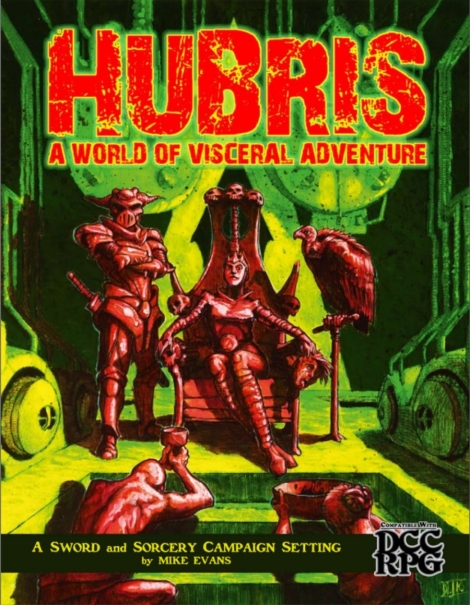 |
| Pretty visceral! |
The question is, of course, is whether it's a good one. As usual, I won't keep you in suspense with my overall verdict: it is quite good. In fact, if you're looking for an out-of-the-box straight-up Appendix N setting for DCC (more Appendix N that Aerth), then this should be near the top of your list of things to consider. Hubris has one foot firmly planted in the school of Conanesque low fantasy, with bloody swashbuckling against evil priests, and serpent men with their armies of slaves. The other foot is rooted in science-fantasy, borrowing from the imagery of steampunk, post-apocalyptic mutations and cybernetic body horror. There are no Clerics or Tolkienesque demi-humans. Like I said, très Appendix N.
All that being said, it's not my perfect supplement. Instead, for me, Hubris in an excellent source of ideas, and perhaps a place my players could visit if the party gets sucked through one of those random portals that adventurers seem to run into. Despite my own misgivings, it may work perfectly for you, so read on to discover what the hell I'm talking about.
Part of what's going on here is that Hubris is such a large work, at 347 pages, that not everything is going to work for me. The alchemist class, for instance, seemed playable, but also seemed a little limited to the idea of being a mere chemist and potion-brewer. The half-demon class sounded a lot like the D&D Tiefling, which has never seemed that interesting to me. Hubris is a dark setting, so the conflicted loner archetype can come off a little Hot Topic in those circumstances (even if he is risking eventual loss of his soul).
In fact, as a whole, it feels a bit overstuffed to me. It sometimes seems as though every "cool" theme and idea got thrown in, and while they all work great on their own, putting them all together can get a little Rifts-like. For instance, there is a Mutant class that comes across very much like, say, a Gamma World or MCC mutant. The mutations are caused by Chaos instead of genetic mutation, but the effect seems nearly identical. That's fine, although it butts up against a medieval monotheistic theocracy and your requisite Viking-style barbarians. And there are also the Avarians i.e. bird-people, which is a viable PC class.
This probably doesn't sound unlike many other similar settings, and of course, that's true. For me, it's a matter of degree. There are so many themes and elements, and not all of them work as well as others. I would have rather that Hubris concentrated on a smaller number of them, making them feel more of a piece. For instance, I really liked rotten Eisenbar and the Metalphage (the latter reminding me very strongly of Iron Man Tetsuo), as well as the Klind, with their Set-worshipping Fleshweavers and their weird advanced technology.
One thing that I do want to praise Hubris for is its usability. It is written very much in a way to be used by the GM at the table (a virtue often highlighted by Bryce Lynch on his tenfootpole blog). The main section of the book consists of sub-sections that correspond to different geographic regions, with tables for encounters and regional features. This serves the GM well in the midst of a gaming session, but it's also a perfectly valid way to actually describe a region. A seasoned GM could run a hexcrawl campaign with Hubris, practically out of the box.
I could probably go on and on, listing the things that I liked about Hubris, as well as the things that I didn't care for. In the end, a GM with a bit of time could trim the setting down to whatever he or she pleases, so for a supplement like this, it's probably better to have too much than too little. Like I said, despite my slight misgivings, I have no regrets about purchasing Hubris, and I can recommend it to any DCC or OSR GM who is interested in this sort of thing.
Perhaps Hubris suffers unfairly in my estimation because I'm coming to it right after reading Crypts and Things Remastered (click here to see my review). Both worlds have a lot in common; they are very grim and bloody Appendix N settings. The both throw out DCC demi-humans and Clerics, although C&T entirely jettisons non-humans as potential PCs. To me, C&T felt tighter and purer, with a more cohesive theme. A world doesn't have to be that big to support a full campaign. It doesn't need a million things going on, because your players will never get to see them all. Hubris has a lot more going on, and magic is also a lot more prominent - technology, doubly so.
If you have players who like options, then Hubris might be the better way to go. Do they want characters who can fly, or shoot guns, or use mutant powers? They could still be Fafhrd if they want, but some players eat this stuff up like nobody's business. Some GMs, too. It really comes down to what kind of material will play better with your group. What Hubris really brings to the table is highly game-ready material. You gotta love it for that.
No comments:
Post a Comment